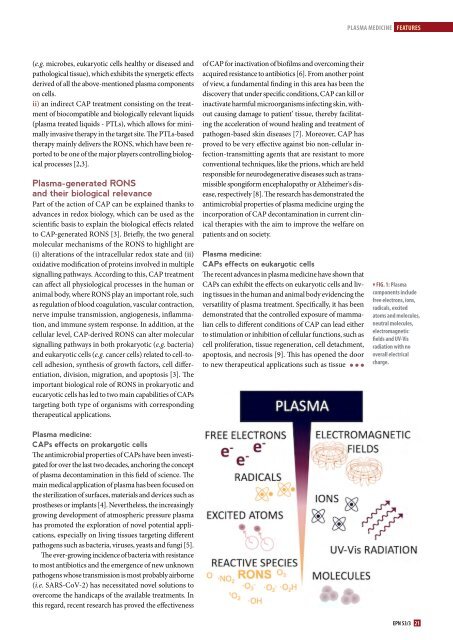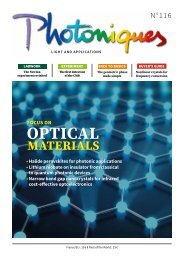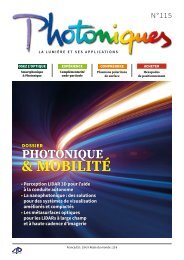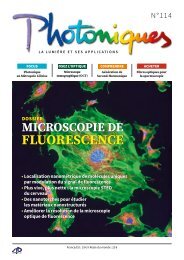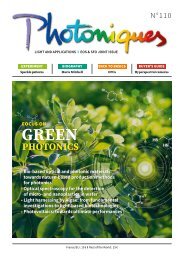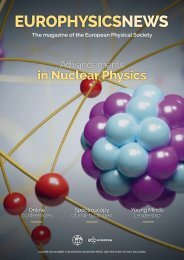EPN 53-3
Create successful ePaper yourself
Turn your PDF publications into a flip-book with our unique Google optimized e-Paper software.
PLASMA MEDICINE<br />
FEATURES<br />
(e.g. microbes, eukaryotic cells healthy or diseased and<br />
pathological tissue), which exhibits the synergetic effects<br />
derived of all the above-mentioned plasma components<br />
on cells.<br />
ii) an indirect CAP treatment consisting on the treatment<br />
of biocompatible and biologically relevant liquids<br />
(plasma treated liquids - PTLs), which allows for minimally<br />
invasive therapy in the target site. The PTLs-based<br />
therapy mainly delivers the RONS, which have been reported<br />
to be one of the major players controlling biological<br />
processes [2,3].<br />
Plasma-generated RONS<br />
and their biological relevance<br />
Part of the action of CAP can be explained thanks to<br />
advances in redox biology, which can be used as the<br />
scientific basis to explain the biological effects related<br />
to CAP-generated RONS [3]. Briefly, the two general<br />
molecular mechanisms of the RONS to highlight are<br />
(i) alterations of the intracellular redox state and (ii)<br />
oxidative modification of proteins involved in multiple<br />
signalling pathways. According to this, CAP treatment<br />
can affect all physiological processes in the human or<br />
animal body, where RONS play an important role, such<br />
as regulation of blood coagulation, vascular contraction,<br />
nerve impulse transmission, angiogenesis, inflammation,<br />
and immune system response. In addition, at the<br />
cellular level, CAP-derived RONS can alter molecular<br />
signalling pathways in both prokaryotic (e.g. bacteria)<br />
and eukaryotic cells (e.g. cancer cells) related to cell-tocell<br />
adhesion, synthesis of growth factors, cell differentiation,<br />
division, migration, and apoptosis [3]. The<br />
important biological role of RONS in prokaryotic and<br />
eucaryotic cells has led to two main capabilities of CAPs<br />
targeting both type of organisms with corresponding<br />
therapeutical applications.<br />
Plasma medicine:<br />
CAPs effects on prokaryotic cells<br />
The antimicrobial properties of CAPs have been investigated<br />
for over the last two decades, anchoring the concept<br />
of plasma decontamination in this field of science. The<br />
main medical application of plasma has been focused on<br />
the sterilization of surfaces, materials and devices such as<br />
prostheses or implants [4]. Nevertheless, the increasingly<br />
growing development of atmospheric pressure plasma<br />
has promoted the exploration of novel potential applications,<br />
especially on living tissues targeting different<br />
pathogens such as bacteria, viruses, yeasts and fungi [5].<br />
The ever-growing incidence of bacteria with resistance<br />
to most antibiotics and the emergence of new unknown<br />
pathogens whose transmission is most probably airborne<br />
(i.e. SARS-CoV-2) has necessitated novel solutions to<br />
overcome the handicaps of the available treatments. In<br />
this regard, recent research has proved the effectiveness<br />
of CAP for inactivation of biofilms and overcoming their<br />
acquired resistance to antibiotics [6]. From another point<br />
of view, a fundamental finding in this area has been the<br />
discovery that under specific conditions, CAP can kill or<br />
inactivate harmful microorganisms infecting skin, without<br />
causing damage to patient’ tissue, thereby facilitating<br />
the acceleration of wound healing and treatment of<br />
pathogen-based skin diseases [7]. Moreover, CAP has<br />
proved to be very effective against bio non-cellular infection-transmitting<br />
agents that are resistant to more<br />
conventional techniques, like the prions, which are held<br />
responsible for neurodegenerative diseases such as transmissible<br />
spongiform encephalopathy or Alzheimer's disease,<br />
respectively [8]. The research has demonstrated the<br />
antimicrobial properties of plasma medicine urging the<br />
incorporation of CAP decontamination in current clinical<br />
therapies with the aim to improve the welfare on<br />
patients and on society.<br />
Plasma medicine:<br />
CAPs effects on eukaryotic cells<br />
The recent advances in plasma medicine have shown that<br />
CAPs can exhibit the effects on eukaryotic cells and living<br />
tissues in the human and animal body evidencing the<br />
versatility of plasma treatment. Specifically, it has been<br />
demonstrated that the controlled exposure of mammalian<br />
cells to different conditions of CAP can lead either<br />
to stimulation or inhibition of cellular functions, such as<br />
cell proliferation, tissue regeneration, cell detachment,<br />
apoptosis, and necrosis [9]. This has opened the door<br />
to new therapeutical applications such as tissue<br />
. FIG. 1: Plasma<br />
components include<br />
free electrons, ions,<br />
radicals, excited<br />
atoms and molecules,<br />
neutral molecules,<br />
electromagnetic<br />
fields and UV-Vis<br />
radiation with no<br />
overall electrical<br />
charge.<br />
<strong>EPN</strong> <strong>53</strong>/3 21


